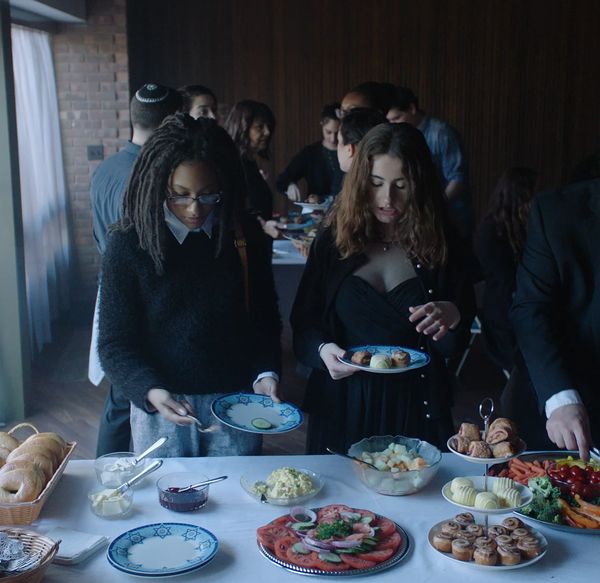 |
| Madeline Grey DeFreece and Rachel Sennott in Tahara |
The story of a troubled relationship between two teenagers which finally explodes at the funeral of one of their classmates, when Hannah (Rachel Sennott) takes advantage of Carrie (Madeline Grey DeFreece) in a way that makes long-buried feelings impossible to ignore, Tahara is a film which first emerged onto the festival circuit in late 2020 and has finally secured a US release. “It feels like a long road,” says director Olivia Peace as we sit down to talk about it, and I tell her that I’m really pleased that, given the chaos in the industry recently, this smart and sensitive little film made it through.
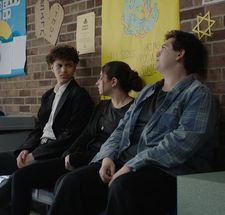 |
| Waiting for life to begin |
One of my classmates died when I was a teenager, I explain, and so I was immediately taken by how real the scenes dealing with the death felt, especially in terms of the sense of disorientation which the characters are feeling. I like the impressionistic style which she uses to convey that.
“With the film itself, I think I was really interested in the idea of surprise,” she says. “Just coming into each scene not quite knowing what's going to happen next. And not explaining it. So in the very beginning, I almost wanted it to be a surprise that they are at a funeral, you know, because conversation they have outside is very normal. They're talking about Instagram, something about posting, and then they walk in. You notice everyone's in black but I mean, that could be anything. And so I'm assuming this does take some time for people to realise that they're at a funeral.
“Funerals are really weird places. Most people, I think, have a real issue with grieving publicly in any way, or even just being very sincere. So funerals can put us at odds, I think. Especially when you're a teenager with like, you're wanting to be cool. And yeah, being genuine, I think, emotionally. And so I think that was the purpose of having things opening like that.”
Hannah doesn't really seem to understand the solemnity of the occasion at all, or that she should be thinking about things other than the boy she likes.
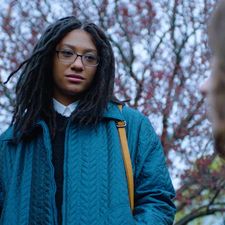 |
| Madeline Grey DeFreece as Carrie |
“Yeah, yeah. And that's pretty much her entire life!” she laughs.
I’m interested in what she said about genuine emotion, and remark that I’m drawn to the tension between the dishonesty of the school’s approach and the journey that Carrie is going on, starting to connect more and more with with who she is.
“It might not be dishonesty so much as, I think, the teacher’s purpose is more to give people scripts of how to get through this occasion, and those scripts are based on tradition. So ‘Don't worry, everyone, I can teach you all how to grieve. I have this workshop with steps. And we'll go step by step. And within this period of time, we'll talk about our feelings according to the script that I have. And then we'll all be fine.’ And I think, yeah, unfortunately, that is like much of our educational system. It’s very much based around giving people the answers to things that are actually quite complex. And so in this particular case, that has to do with ‘Yeah, this is how we grieve properly.’ And so of course, people don't really take it seriously, I think. Almost instinctively, they understand ‘This isn't a place where I should be honest,’ and it's not until the very end. I think that's where it kind of breaks with that script and disrupts things a little bit.”
And that central friendship is so important to the whole film. It takes me back to the idea that the Victorians about passionate friendships between women, which were almost romantic without quite admitting it. There are different kinds of love going on between the two girls and nothing is straightforward. How did she get the actors into the right space for that?
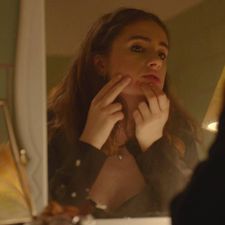 |
| Racel Sennott as Hannah |
“Some of that is we got really, really lucky,” she says, “because Rachel and Madeline just happen to be great people and got along really, really well. The truth of the matter is they literally met the night before the shoot. I think the thing that really helped them was, way before we started filming, Jess and I wrote really complex and detailed backstories for each of them about how long they’ve been friends, different memories they might have together, and we talked about it as a group and kind of separately, and just developed these stories over time.
“At the very beginning there’s this montage of photos of their friendship over time, from when they’re little children to the age that they are now. Some of those photos didn’t even make it into the film. I think that helped to ground them in this friendship yourself and I think that was really the element that made it real for them, more than anything else. I hadn’t seen a lot of that growing up...I really wanted, more than anything, to make sure that felt real.”
I also find the friendship interesting because of the way it seems to be changing, perhaps due to the stage that they're at in their lives. Hannah’s power seems to be declining as behaviours which might seem cool at school don’t fit in the adult world which they’re moving into.
“Yeah, that’s a good observation.” she says. “Something we talked about a fair amount was this idea that Hannah has been pining for popularity and seeking to achieve it, and now she thinks she has it, whereas Carrie is someone who, effortlessly, is cool, even with what she chooses to wear to the funeral. When it came to the styling between the two of them, when we were looking for a costume designer, ultimately what we settled on was that Hannah is wearing a homecoming dress that she literally wore to her homecoming five years before. Hannah’s someone who would wear a homecoming dress to a funeral, whereas Carrie’s trying to be casual, she’s kind of laid back and people generally like her because of that, even though she’s not really aware of it just yet.”
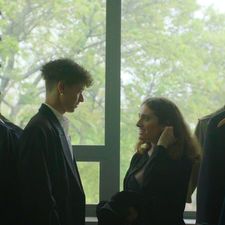 |
| Not the time or the place |
Hannah always seems to be on the brink of getting herself into really embarrassing situations and is the kind of character films often mock, but here there’s a very careful balance of sympathies. How was that achieved?
“Yeah, I mean, that's something that we talked about a fair amount. When I first got the original draft of the script, I think it was mocking Hannah quite a bit as well as their teachers character, so something we talked about was even when a character is doing something that you personally find reprehensible, you should respect the decision that they make. That was really important to me. That’s how I try to carry on in life too, to a certain degree.”
The film was shot in a real synagogue, Temple Beth-El in Rochester, New York. Did that affect the way filming took place?
“Absolutely. Luckily. Though it was also kind of unlucky because Temple Beth-El was going through renovation the entire shoot. So it was pretty empty. But we still got this great experience on location, and not just any location: Jess literally went to synagogue there when she was growing up. It helped us tons, even down to the staff If we had any question both about our shooting schedule or, more importantly, about Judaism, about getting these cultural elements right, they were right there and really happy to help and excited for us. It was so cool.” She beams. “Sometimes they were peeking in on our live set, which was really cool to see. And it’s literally where Jess envisioned it in her mind.
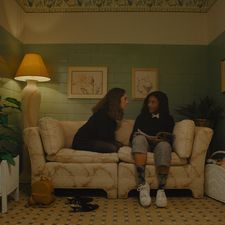 |
| Pushing boundaries |
“Sometimes it was difficult because it is a real place, it’s not a set. So, for instance, I planned a 360 dolly shot for that big kiss scene in the bathroom, but we couldn’t get the dolly track in there.” She laughs. “It required a certain level of inventiveness, especially since, again, it was literally being renovated as we were working, so each day we had to be flexible. For instance, we’d be planning to shoot a scene in the actual sanctuary and then we’d get there and there would be no chairs. Or another thing was, one day we had this beautiful scene planned for after the funeral luncheon, and we got there that day and they had completely gutted the room. So yeah, it required a certain level of flexibility, but I think it was a real net positive because of how welcoming everyone was – and I ended up learning a lot about Judaism from the experience of filming there, and that was really cool.”
Did that influence her decision to shoot in square aspect ratio, or was that something she always wanted to do?
“That was something I always wanted to do from the time I read the script. And I did not know that it was going to work. When I read the script for the first time I was really taken by this idea of just, like, loneliness. I think from the beginning I really connected with Carrie. And I'd been watching a lot of films that had a huge, wide anamorphic aspect ratio. You could fit a crowd of people in there. So I kind of wondered what would happen if the frame was really small and you could fit only one person in the frame. And then I took to Instagram to try to research things and at the time there was just the square aspect ration on Instagram. And I would see these teens’ selfie videos, like confessional style sometimes. There was something I thought was so endearing about that, about only being able to fit one body in a frame and what that might feel like.
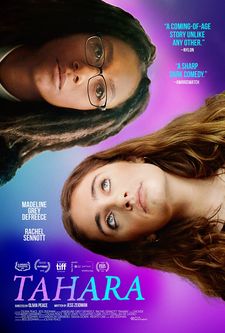 |
| Tahara poster |
“Again, we had no idea if this would work or not. We got the filming and it ended up being a real blessing honestly, in that we didn't have very much money. We could be very tight and specific with our shots. So for instance, if this room is under construction and everything outside this frame is looking a mess and the carpet is all torn up, we can completely frame everything out. Jayne [Clark], our production designer, was really great about going to yard sales and finding all that stuff we could put in our frame to make it look really intentional and really old, and fit the style that we had, without giving away everything beyond that frame.”
It felt to like it was reflective of the very small psychological space that the girls are in at that time – their lives are about to open up, and in this world everything is still small, I suggest. She agrees, and says that she thinks it works with the difficulty that Hannah, in particular, has with figuring out the appropriate way of reacting to events around her. “Which is so much of what being a teenager is. You have not been alive that long. You haven't had that many experiences. So every small hiccough in your life feels monumental and devastating. Again, I really wanted to respect that.”
So what is she working on now?
“Getting this film out into the world is first on my mind,” she says. “I also just graduated from my master's programme at USC, where I actually studied interactive media and games, so, like, coding and virtual reality; and I made another film using artificial intelligence algorithms, and that was a pretty cool experience. Also I have a sci-fi film that I’m putting together now and I’m pretty excited about. It’s also a break-up film. So we’ll see.”
Tahara opens at the Quad Cinema in New York on Friday, 10 June, with other venues to follow.





















